Heat | Term 2 Unit 1 | 6th Science - Student Activities | 6th Science : Term 2 Unit 1 : Heat
Chapter: 6th Science : Term 2 Unit 1 : Heat
Student Activities
Activity 1: Take three bowls. Pour very cold water in the first bowl. (you can also add ice cube for cooling). Place luke warm water in the second. Half fill the third with hot water (-not hot enough to burn!) Set them in a row on the table, with the lukewarm water in the center. Place your right hand in the cold water, and your left hand in the hot water. Keep them in for a few minutes. Then take them out, shake off the water and put both into the middle bowl. How do they feel?
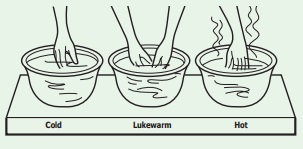
Priya says, “My right hand tells me that the water in the bowl is hot and the left hand tells me that the same water is cold.”
Write down in your own words what do you experience? Discuss in the class why this happens.
Priya's right hand first touches the cold water. Then it touches lukewarm water. Her hand changes from low temperature to high temperature. So she feels that the water is hot.
Priya's left hand first touches the hot water. Then it touches the lukewarm water. Her left hand changes from high temperature to low temperature. So she feels that the water is cold.
When you placed your left hand in the hot tub, the heat from the bowl made the molecules on your hand vibrate faster. When you keep the same hot hand in the second bowl the vibrations transferred from your hand to make the particles in the water vibrate. Therefore you feel loss of heat and hence your hand feels cold.
In the same way, your right hand which was placed in cold water, feels hot when you insert it into the lukewarm water. Because it takes heat energy from lukewarm water.
So, the same lukewarm water gives your hands different feeling according to the temperature of your hand. Measuring temperature by touching is not correct.
Thermometers are used to measure temperature accurately and quantitatively.
Activity 2: The Temperature of Boiling Water
Take water in a vessel and place the vessel on a stove. Fix the thermometer as shown in figure (Caution: The thermometer should not touch the vessel in which the water is being heated. Otherwise the thermometer will be broken at high temperature.)
All students have to read the temperature of the water and note the reading on the blackboard. Do you notice that the temperature is raising?
What is the temperature of water when it is boiling?

Does the temperature of the boiling water rise further after that?
When boiling water is heated for some time, the water continues to receive more heat, but it's temperature does not rise further. The point at which the water boils and temperature becomes stable is called the boiling point of water.
Guess and Write:
(Check your assumption with the help of a thermometer.)
* Approximate temperature of the tea when you drink 60°C
* Approximate temperature of cool lemon juice when you drink 10°C
Normally, the room temperature of water is approximately 30oC. When we heat water, its temperature raises and it boils at 100oC. If we cool the water, it freezes at 0oC.
( Note : you have to say 30ºC as 30 degree celsius or 30 degree centigrade)
Is Neela correct?
Beaker A and B has water at 80o C.
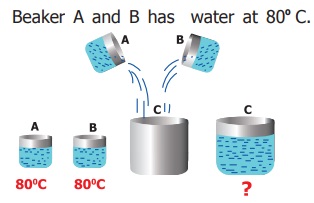
Then pour the water of A and B to an empty beaker C. Now, What is the temperature of the water in the beaker C? Neela says it will be 160oC.
80oC + 80oC = 160oC Am I right ?
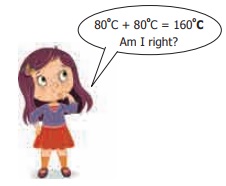
What is your opinion? Does Neela say correctly? Make a guess and verify it experimentally.
160° C is wrong. Its 80°C. Volume changes but heat per volume don’t change.
One day in 1922, the air temperature was measured at 59ºC in the shade in Libya, Africa. The coldest temperature in the world was measured in the Antarctic continent. It was appromately 89ºC. The minus sign (–) is used when the temperature falls below the freezing point of water, which is 0ºC. If water becomes ice at 0ºC, you can imagine how cold 89°C would be. Our normal body temperature is 37ºC. Our body feels cool if the air temperature is around 15 to 20 degree Celsius.

Can you estimate the night temperature in your village or city during winter?
Activity 3: Take one litre water in a pan, and heat it on a stove. Calculate the time taken to start boiling. (i.e. the time taken to thermometer reading goes up to 100oC). Take five litre water in another pan and heat it on the same stove. Calculate the time taken by the water to start boiling.
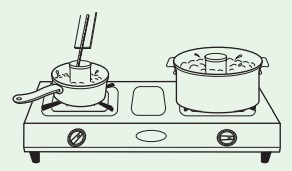
In which pan the water starts to boil earlier?
__ One litre water
✔ Five litre water.
Both, however, show a temperature of 100oC at the boiling point. Five litre water takes more time to boil i.e. more heat is needed to boil the larger amount of water. So, five litre boiling water has more heat energy than one litre water.
Place an open can of lukewarm water in each pan. Observe their temperature to find out which can gets hotter.
In which can water shows quick rise in temperature?
✔ Can in One litre boiled water
__ Can in five litre boiled water.
You can see that, five litre water pan will raise the can of water to a higher temperature. Though, both pans of boiling water have the temperature of 100oC the five litre water can give off more heat energy than one litre water. Because it has more heat energy, and gives more energy to the water in the can.
Total heat is measured by calorie, the amount of heat needed to raise one gram of water by one degree centigrade.
* Which has more heat energy in each pair? Put ✓ mark.
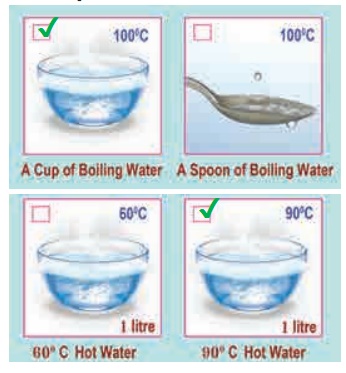
Let Us Think
Pavithra is having tea while watching the pond near her house. Surely, tea is in higher temperature than the water in the pond. Now, a question is arising in Pavithra’s mind. Which one has more heat energy, a cup of tea or the water in the pond? What do you think? _______ ______, _________
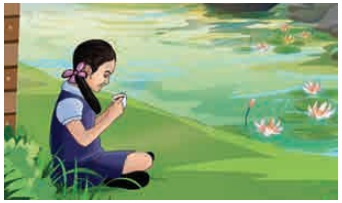
The temperature determines the direction of flow of heat.
1. You are holding a hot cup of coffee. Would the Heat energy transfer from
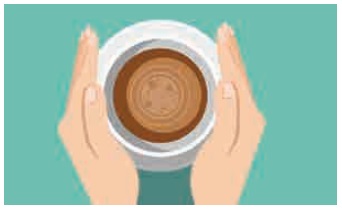
a. Your body to the coffee, or
b. The coffee to your body?
The heat energy gets transferred from the coffee to my body.
2. You are standing outside on a summer day. It is 40ºC outside (note that normal body temperature is 37ºC). Would the Heat energy transfer from.
a. Your body to the air particles, or
b. The air particles to your body?

Heat energy flows from air particles to my body.
3. You are standing outside on a winter day. It is 23ºC outside. Would the heat energy transfer from:
a. Your body to the air particles, or
b. The air particles to your body?

The heat energy transfer is from my body to the air particles.
Activity 4:
Hammer a nail into a tin can. Ease the nail out. Put it in again to make sure that the hole is large enough for the nail. Then, holding the nail with a pair of pliers, scissors or forceps, heat the nail over a candle, in hot water, or over the stove. Try to put it into the hole in the can.
I see that:
You will see that, now it is hard to put the nail into the hole. Heat expands solids. The molecules in the solid move faster, spread apart and occupy more space.
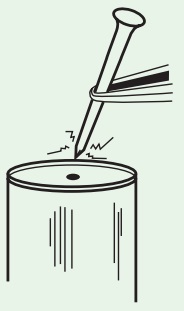
Activity 5:
Linear Expansion
Take a bulb, dry cell, candle, cycle spoke, coin (or broad - headed nail) and two wooden blocks.
Place one end of the cycle spoke on a wooden block and connect an electric wire to it. Put a stone over the spoke to hold it firmly in place on the wooden block, as shown in Figure . The spoke should be parallel to the ground. Place the second wooden block under the free end of the spoke. Wrap some electric wire around the coin (or nail) and place it on the block. You may put a stone over the coin to hold it in place.
Connect a bulb and dry cell to the free ends of the wires connected to the coin and the spoke and make the circuit shown in the figure.
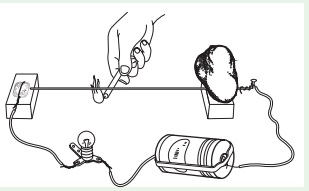
When the tip of the free end of the spoke touches the coin, the circuit is completed and the bulb lights up. Check to ensure this. If the bulb does not light up, it means the circuit is not complete, so check your connections properly. (Note: We will learn about electric circuit elaborately in electricity lesson.) Now slide a page of your book between the coin and spoke and then slide it out. That way you would get a gap between the coin and spoke equal to the thickness of the sheet of paper.
* Does the bulb light up? If it does not, what could be the reason?
The bulb does not light up. There is a gap between the coin and the spoke. So the electrical circuit is not complete. Therefore the bulb does not light up.
You saw that the bulb does not light up when the spoke does not touch the coin. Now light the candle and heat the spoke with it.
• Did the bulb light up after the spoke was heated for some time?
Yes, the bulb lit up.
• If it did, then explain how the spoke touched the coin after it was heated.
When the spoke was heated it expanded in length and it touched the coin.
• Why does the bulb go off some time after the candle is taken away from the spoke?
When the candle is taken away the spoke becomes cool. It contracts. There is a gap between the spoke and the coin. As the circuit breaks the bulb goes off.
• What happens to the length of the spoke when it is heated or cooled?
When heated the spoke undergoes linear expansion. When cooled the spoke contracts in length.
Activity 5:
Cubical Expansion
Take a metal ring and metal ball of such size that the ball just passes through the ring.
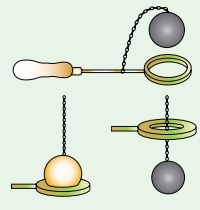
• Heat the ball and check whether it passes through the ring.
__ Passed through
✔ Not passed through
• Now let the ball cool down, and check whether it passes through the ring.
✔ Passed through
__ Not passed through
Solids expand due to heat and come back to the original state if heat is removed.
Glassware used in kitchen and laboratory are generally made up of Borosilicate glass (pyrex glass). The reason is that the Borosilicate glass do not expand much on being heated and therefore they do not crack.

* The photographs below show an expansion joint at the end of a bridge in winter and in summer. Which season is shown in each picture? Explain how do you know?
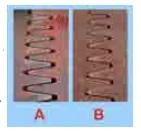
A. Photograph A is taken in winter. As the climate is cool, the edges contract. So there is a wide gap.
B. Photograph B is taken in summer. As the climate is hot the edges expand. So the gap becomes small.
Related Topics